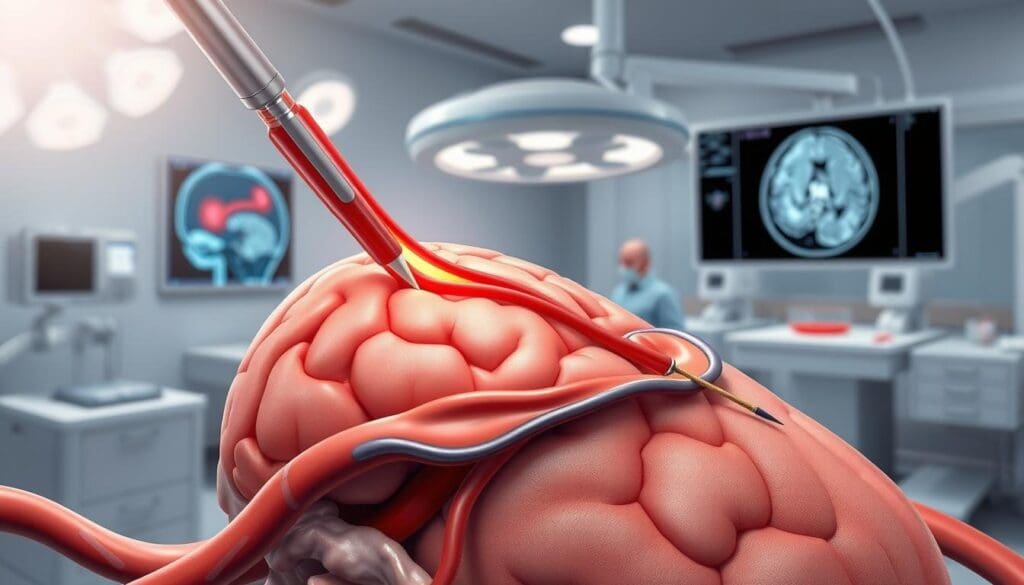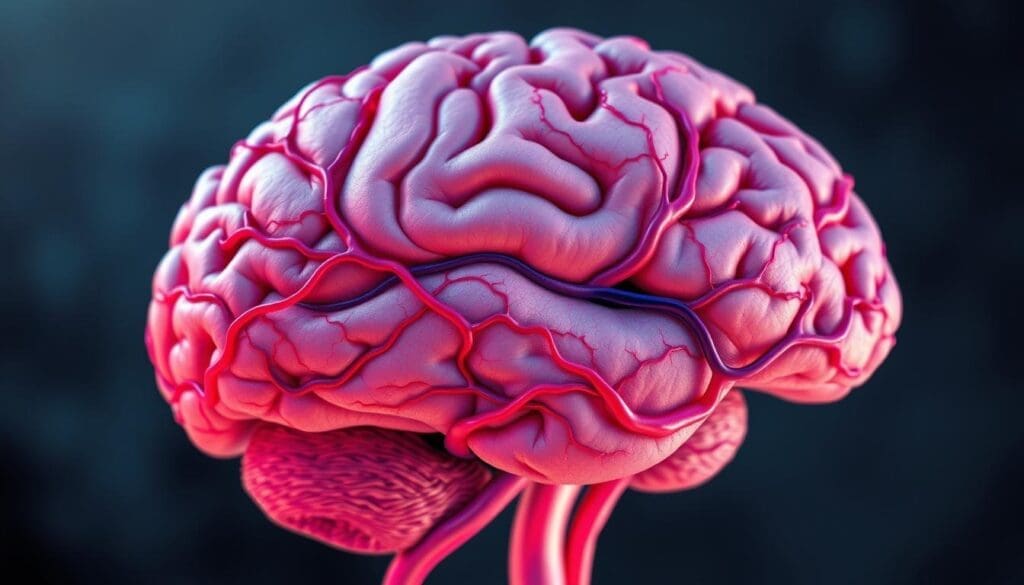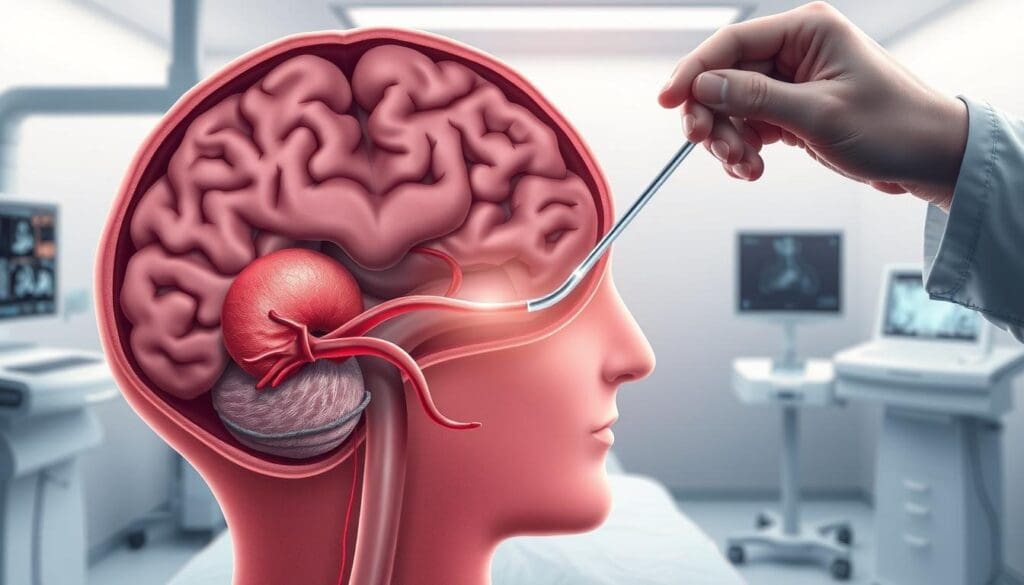Last Updated on November 26, 2025 by Bilal Hasdemir

At Liv Hospital, we know that a brain embolization can seem scary. But with new methods and care that puts you first, we’re here to help. Your health and well-being are our main focus.
Cerebral embolization procedures are small, non-invasive treatments. They fix abnormal blood vessels in the brain, like aneurysms and arteriovenous malformations. Knowing more about these treatments helps patients make better choices for their care.
We want to give you the power to make informed decisions. Our team is here to support and guide you every step of the way. We make sure you’re informed and comfortable with your treatment.
Key Takeaways
- Minimally invasive treatment options are available for abnormal blood vessels in the brain.
- Brain embolization is used to treat conditions such as aneurysms and arteriovenous malformations.
- Patient-centered care is our top priority at Liv Hospital.
- Innovative techniques improve outcomes for patients undergoing cerebral embolization procedures.
- Our team provides complete support and guidance throughout the treatment process.
Understanding Brain Vascular Abnormalities

Brain vascular abnormalities are complex and need a detailed approach for diagnosis and treatment. These conditions affect the brain’s blood vessels, leading to serious health problems. Each type of abnormality has its own risks and complications.
Common Types of Brain Vascular Abnormalities
There are several types of brain vascular abnormalities. These include aneurysms, arteriovenous malformations (AVMs), and embolisms. An aneurysm is a bulge in a blood vessel that can burst, causing brain bleeding. An arteriovenous malformation is an abnormal connection between arteries and veins, leading to bleeding or other issues. An embolism happens when a blood clot blocks a vessel, potentially causing a stroke.
How These Abnormalities Affect Brain Function
These vascular issues can greatly affect brain function. For example, an aneurysm rupture can cause severe headache, loss of consciousness, and even death. AVMs can lead to seizures, headaches, and neurological problems due to abnormal blood flow. Embolisms can cause sudden weakness, trouble speaking, and vision changes.
Why Treatment Is Often Necessary
Treatment is often needed to prevent or lessen the problems caused by brain vascular abnormalities. For aneurysms, treatment might involve clipping or coiling to stop rupture. AVMs may be treated with embolization, surgery, or radiosurgery, based on size and location. Embolisms are usually treated with thrombolytic therapy or mechanical thrombectomy to improve blood flow.
Knowing the specific type of brain vascular abnormality and its effects is key to finding the right treatment. We work with patients to create a treatment plan that meets their unique needs and conditions.
What Is a Brain Embolization Procedure?

The brain embolization procedure is a minimally invasive method. It treats abnormal blood vessels in the brain. It cuts off the blood supply to the affected area.
Definition and Basic Principles
Brain embolization, or endovascular embolization, uses a catheter to deliver materials to the brain. An interventional neuroradiologist does this. The goal is to block abnormal blood vessels.
This method redirects or blocks blood flow. It uses materials like coils, liquids, or particles. The choice depends on the condition being treated.
History and Development of the Technique
Embolization has come a long way. It was first used for bleeding or vascular malformations. Now, thanks to technology and imaging, it treats many brain issues.
New materials and better catheters have made it safer and more effective. Today, it’s a key part of neurointerventional radiology.
When Embolization Is Recommended
It’s used for aneurysms, AVMs, and some tumors. The choice depends on the abnormality’s size, location, and the patient’s health.
Coil embolization for an aneurysm is often chosen when there’s a risk of rupture. It’s also used for AVMs to reduce bleeding risk and symptoms.
Understanding brain embolization helps patients and doctors make better treatment choices. It’s key for complex brain vascular conditions.
The Difference Between Aneurysms and Embolisms
It’s important to know the difference between aneurysms and embolisms for those with vascular issues. Both affect blood vessels but in different ways. This knowledge helps in choosing the right treatment.
Defining Aneurysms: Weakened Blood Vessel Walls
An aneurysm is a bulge in a weakened blood vessel wall. It can happen in any blood vessel, but often in the brain or aorta. Aneurysms are risky because they can burst, causing severe bleeding.
High blood pressure, smoking, and a family history of aneurysms increase the risk. A renowned neurosurgeon says, “Aneurysms are like ticking time bombs; they need careful watching and sometimes need to be treated to prevent rupture.”
Understanding Embolisms: Blockages in Blood Vessels
An embolism happens when something blocks a blood vessel. This can be a blood clot, an air bubble, or another object. It can cause damage or organ problems, depending on where it happens.
“The key to treating an embolism is finding out where it came from and stopping more from forming,” A specialist in vascular medicine explains.
Why This Distinction Matters for Treatment
The difference between aneurysms and embolisms is key because their treatments are different. Aneurysms might need surgery or a procedure to stop them from bursting. Embolisms might need medicine to thin the blood or dissolve clots to get blood flowing again.
“Knowing if someone has an aneurysm or an embolism is not just about words; it affects how we treat them and their chances of getting better,”
Medical consultant, Neurosurgery Department
.
In summary, while both aneurysms and embolisms are serious, knowing the difference is vital for the right treatment. This targeted care can lead to better health outcomes for patients.
Key Fact #1: Embolization Procedure Brain Is Minimally Invasive
Minimally invasive brain embolization procedures have changed how we treat brain problems. They use catheters inserted through arteries, avoiding big cuts. This makes them different from old surgery methods.
Comparison to Traditional Open Surgery
Old surgery for brain issues needs big cuts and takes longer to recover. Brain embolization procedures use small skin punctures, usually in the groin. This cuts down on damage and speeds up healing.
- Smaller incisions reduce the risk of infection and promote faster recovery.
- Less tissue damage results in fewer complications and less post-operative pain.
- Shorter hospital stays are often possible, reducing healthcare costs and the risk of hospital-acquired infections.
Benefits of Catheter-Based Approaches
The use of catheter-based approaches in embolization procedures brings many advantages, including:
| Benefit | Description |
| Precision | Catheters allow for precise delivery of embolic materials to the target area. |
| Reduced Risk | The minimally invasive nature reduces the risk of complications associated with open surgery. |
| Faster Recovery | Smaller incisions and less tissue damage result in quicker recovery times. |
Patient Eligibility Considerations
While minimally invasive brain embolization is good for many, not all can have it. The size and location of the problem, and the patient’s health, matter. We check these things to see if brain embolization surgery is right for you.
We look at each patient’s situation to decide if brain embolization surgery is the best choice. This helps ensure the best results for you.
Key Fact #2: Types of Brain Embolization Techniques
Brain embolization procedures have evolved to include several techniques. Each is tailored to specific vascular conditions. The choice of technique depends on the nature of the vascular abnormality, its location, and the patient’s overall health.
Coil Embolization for Aneurysms
Coil embolization is a widely used technique for treating aneurysms. It involves deploying coils into the aneurysm sac to induce clotting. This prevents further blood flow into the aneurysm.
This minimally invasive procedure is performed through a catheter inserted into an artery in the leg. It is guided to the site of the aneurysm under imaging guidance.
The use of coil embolization has revolutionized the treatment of aneurysms. It offers a safer alternative to open surgery for many patients. The procedure is typically performed under general anesthesia to ensure patient comfort and procedural success.
Liquid Embolic Agents for AVMs
Liquid embolic agents are used to treat arteriovenous malformations (AVMs). These agents are delivered through a microcatheter directly into the AVM. They fill the nidus and draining veins to achieve complete occlusion.
The choice of liquid embolic agent depends on the characteristics of the AVM and the operator’s preference. Liquid embolization offers a high degree of control and precision. It is an effective treatment for complex AVMs.
Particle Embolization Methods
Particle embolization involves using small particles to occlude blood vessels or vascular malformations. This technique is often used for tumors and certain vascular malformations. The particles are injected through a catheter into the target vessel, reducing blood flow to the lesion.
Particle embolization is valued for its ability to selectively target specific areas. It minimizes damage to surrounding tissues. The choice of particle size and type depends on the specific condition being treated.
Choosing the Right Technique for Different Conditions
The selection of an embolization technique depends on various factors. These include the type and location of the vascular lesion, the patient’s health status, and the preferences of the treating physician. A multidisciplinary team approach is often used to determine the most appropriate treatment plan.
By understanding the different types of brain embolization techniques, patients and healthcare providers can make informed decisions. Each technique has its indications, benefits, and risks. These must be carefully considered in the context of the individual patient’s condition.
Key Fact #3: The Step-by-Step Process of Cerebral Embolization
The cerebral embolization process is detailed and precise. It starts with preparation, moves to the procedure itself, and ends with aftercare. This method is used to treat brain vascular problems effectively.
Pre-Procedure Preparation
Before starting, patients go through a detailed check-up. This ensures they’re ready for the procedure. They review their medical history, have imaging tests like angiograms, and talk about their current medications.
They’re often told to stop taking blood thinners before the procedure. This is to lower the risk of bleeding. They also might need to fast for a few hours beforehand.
The Catheterization Process
The catheterization step is key in cerebral embolization. A small catheter is inserted into an artery, usually in the groin or wrist. This is done under local anesthesia.
The catheter is then moved to the brain’s target area using imaging. Contrast dye is used to see the blood vessels clearly. This helps the doctor plan the treatment.
Delivery of Embolic Materials
With the catheter in place, the next step is to deliver embolic materials. These can be coils, liquid agents, or particles. They block blood flow to the targeted area.
The type of material used depends on the condition being treated. The doctor chooses and uses the right material to get the best results.
Completion and Immediate Post-Procedure Care
After the procedure, the catheter is removed, and the site is closed. Patients are then watched closely in a recovery area.
They’re checked for any complications, pain is managed, and they’re kept stable. Follow-up care is important to see how they’re doing and if the treatment worked.
Key Fact #4: Success Rates and Effectiveness
Brain embolization procedures are very successful in treating aneurysms and arteriovenous malformations. We will look at the success rates, what affects them, and how patients do long-term after embolization.
Statistical Outcomes for Aneurysm Embolization
Research shows aneurysm embolization works well, with a high success rate. The success rate is between 80% and 90%. This depends on the aneurysm’s size, location, and shape.
Advanced techniques and materials, like coil embolization and flow-diverting stents, help achieve these high success rates. For example, a study found coil embolization works for 95% of small aneurysms.
Effectiveness for Arteriovenous Malformations
Embolization for AVMs is often combined with other treatments. The success rate for AVM embolization is about 50% to 70%. This depends on the AVM’s complexity.
The success of embolization for AVMs also depends on the AVM’s size, location, and how it drains blood. New embolization techniques, like liquid embolic agents, have improved results for AVM patients.
Factors That Influence Success Rates
Several things affect the success of brain embolization procedures. These include:
- The size and location of the vascular abnormality
- The patient’s overall health and comorbidities
- The experience and skill of the interventional neuroradiologist
- The specific embolization technique and materials used
Knowing these factors helps set realistic expectations and improve treatment results.
Long-Term Outcomes and Recurrence Rates
Long-term results after brain embolization are usually good, with a low chance of recurrence. But there is a risk of recurrence, mainly if the treatment is not complete.
It’s important to have regular follow-up imaging to watch for recurrence. Our institution stresses the need for long-term care and monitoring to get the best results for our patients.
Key Fact #5: Potential Risks and Brain Embolization Side Effects
Patients need to know about the risks and side effects of brain embolization. We work hard to make sure the procedure is safe and effective. But it’s key to know about possible complications that can happen.
Common Minor Complications
Minor issues can happen with brain embolization. These are usually not serious and often get better on their own. Some common ones include:
- Temporary headache or discomfort
- Mild allergic reactions to the contrast material used during the procedure
- Minor bleeding or bruising at the catheter site
These minor problems are usually easy to handle and don’t affect the treatment’s success much.
Serious Potential Risks
Even though rare, serious problems can happen with brain embolization. These include:
- Stroke or cerebral ischemia due to the blockage of a blood vessel
- Bleeding or hemorrhage in or around the brain
- Neurological damage resulting from the procedure
- Infection at the site of the catheter or within the brain
Patients need to know about these serious risks. They should talk about them with their healthcare provider.
How Physicians Minimize Complications
We use several ways to lower the risk of complications:
- Careful patient selection and pre-procedure evaluation
- Use of advanced imaging techniques to guide the procedure
- Employment of experienced and skilled medical professionals
- Adherence to strict sterile techniques to prevent infection
By taking these steps, we can make the procedure safer for everyone.
Risk Factors That May Increase Complication Rates
Some factors can make complications more likely during or after brain embolization. These include:
- Pre-existing medical conditions, such as diabetes or hypertension
- Advanced age or frailty
- Previous history of stroke or neurological disorders
- Complex vascular anatomy or challenging lesion characteristics
Knowing these risk factors helps us tailor the treatment to each patient’s needs.
Key Fact #6: Recovery and Aftercare Following Brain Embolization
Recovery and aftercare are key to the success of brain embolization. We help patients through this important time. We make sure they get the care they need for their well-being and best results.
Immediate Post-Procedure Recovery
After the procedure, patients go to a recovery area. Medical staff watch over them closely. Immediate post-procedure recovery includes managing pain, watching for complications, and checking the brain’s health.
This time can be scary for patients and their families. Our team is here to reassure and care for them, answering any questions they have.
Hospital Stay Duration
The time in the hospital after brain embolization varies. Typically, patients stay for observation to check for any immediate problems and to see how they’re recovering.
Our doctors look at each patient’s situation to decide how long they should stay. They balance watching over the patient with their comfort and wishes.
At-Home Recovery Guidelines
When patients go home, they start the at-home recovery phase. They need to follow certain rules for a safe and easy recovery. This includes taking medicine as directed, watching for any health changes, and slowly getting back to normal activities.
- Rest and avoid strenuous activities.
- Follow medication instructions carefully.
- Monitor for any changes in neurological status or overall health
Follow-Up Care and Monitoring
Follow-up care is very important for recovery. It lets us see how well the embolization worked and handle any issues that come up. We schedule check-ups to track the patient’s progress and adjust their care if needed.
We are committed to comprehensive follow-up care. This helps patients get the support they need during their recovery. It improves their chances of a good outcome.
Conclusion: Making Informed Decisions About Brain Embolization
Patients need to understand brain embolization procedures. This knowledge helps them make better choices about their treatment. By knowing the facts and risks of endovascular embolization, patients can find the right care options.
Brain embolization is a complex treatment for vascular problems like aneurysms and embolisms. We’ve looked at the different methods, advantages, and possible dangers of these treatments.
Patients should talk to their doctors about their situation and treatment options. This way, they can choose the best treatment for their condition.
We want patients to be involved in their care. This ensures they get the right treatment for their specific needs.
FAQ
What is brain embolization?
Brain embolization is a minimally invasive procedure. It treats brain vascular problems like aneurysms and AVMs. It blocks or reduces blood flow to the affected area.
What is the difference between an aneurysm and an embolism?
An aneurysm is a weak spot in a blood vessel wall. An embolism is a blockage in a blood vessel. Knowing the difference helps choose the right treatment.
How is brain embolization performed?
It uses a thin tube guided through blood vessels. Embolic materials, like coils or liquids, are delivered to block blood flow.
What are the benefits of brain embolization compared to traditional open surgery?
It’s less invasive, reducing risks and recovery time. It also leaves fewer scars, making it a popular choice.
What are the risks and side effects of brain embolization?
Risks include minor issues like headaches or nausea. Serious risks like stroke or vessel injury are also possible. Doctors work to minimize these risks.
How long does it take to recover from brain embolization?
Recovery time varies. Most patients stay in the hospital for a few days. They follow guidelines for at-home recovery and have follow-up care.
What is the success rate of brain embolization for aneurysms and AVMs?
Success rates vary based on lesion size and location. Rates range from 70% to 90% or more in some cases.
Can brain embolization be used to treat other conditions?
Yes, it can treat vascular malformations or tumors. The technique used depends on the patient’s condition and treatment goals.
How do I know if I am a candidate for brain embolization?
A healthcare provider will evaluate your condition and history. They will recommend the best treatment options for you.
What is endovascular embolization?
It’s another name for brain embolization. It’s a minimally invasive procedure to treat vascular abnormalities by blocking blood flow.
What is coil embolization?
Coil embolization is a technique in brain embolization. Small coils are used to block blood flow to an aneurysm or lesion. This helps prevent rupture.
References
- Kato, Y., et al. (2019). Expert Consensus on the Management of Brain Arteriovenous Malformations. Journal of Neurointerventional Surgery. https://www.ncbi.nlm.nih.gov/pmc/articles/PMC6896626/






